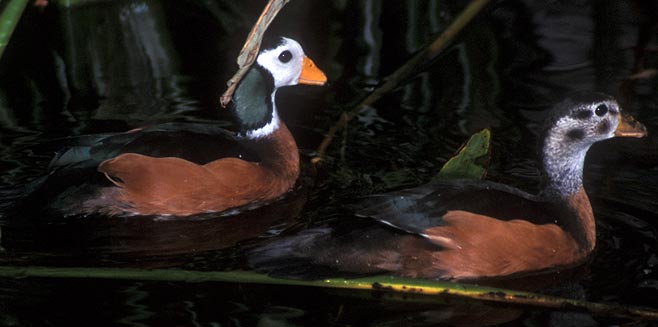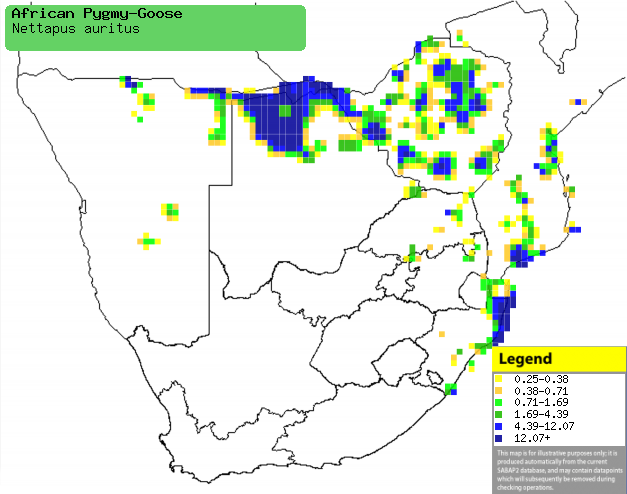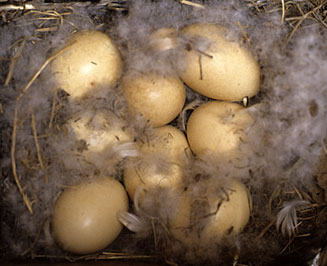|
Nettapus auritus (African pygmy-goose, Pygmy goose)
Dwerggans [Afrikaans]; Kamugcara (check: same name as
Red-billed buffalo weaver and oxpeckers) [Kwangali]; Afrikaanse dwerggans
[Dutch]; Anserelle naine [French]; Afrikanische zwerggans [German];
Pato-orelhudo [Portuguese]
Life
> Eukaryotes >
Opisthokonta
> Metazoa (animals) >
Bilateria >
Deuterostomia > Chordata >
Craniata > Vertebrata (vertebrates) > Gnathostomata (jawed
vertebrates) > Teleostomi (teleost fish) > Osteichthyes (bony fish) > Class:
Sarcopterygii (lobe-finned
fish) > Stegocephalia (terrestrial
vertebrates) > Tetrapoda
(four-legged vertebrates) > Reptiliomorpha > Amniota >
Reptilia (reptiles) >
Romeriida > Diapsida > Archosauromorpha > Archosauria >
Dinosauria
(dinosaurs) > Saurischia > Theropoda (bipedal predatory dinosaurs) >
Coelurosauria > Maniraptora > Aves
(birds) > Order: Anseriformes
> Family: Anatidae
 |
|
African pygmy-goose male (left) and female
(right). [photo Peter Steyn
©] |
Distribution and habitat
Occurs across sub-Saharan Africa, including southern Africa.
Within southern Africa it is locally common in parts of
Zimbabwe, northern Botswana, Mozambique, Limpopo Province and KwaZulu-Natal. It
is quite habitat specific, preferring inland wetlands with emergent vegetation,
especially water lilies, occasionally occupying open swamps, farm dams, river
pools and estuaries.
|
 |
|
Distribution of African pygmy-goose in southern Africa,
based on statistical smoothing of the records from first SA Bird Atlas
Project (©
Animal Demography unit, University of
Cape Town; smoothing by Birgit Erni and Francesca Little). Colours range
from dark blue (most common) through to yellow (least common).
See here for the latest distribution
from the SABAP2. |
Predators and parasites
- Predators:
- Parasites
- Freyana anatina (feather mite)
- Schistosomes
- Trichobilharzia duboisi
- Gigantobilharzia nettapi
Food
It mainly eats the seed pods and fruit of water-dwelling
plants, especially water lilies, using a variety of foraging techniques such as
surface feeding and diving. The following food items have been recorded in its
diet:
- Plant matter
- bulbs, flowers and seeds of water lilies
- Nymphaea nouchali (Blue water lily)
- Nymphoides indica (Small yellow water lily
- grass seeds
- Digitaria ternata (Blackseed finger grass)
- Digitiaria ciliaris (Tropical finger grass)
- Panicum subalbidum (Elbow buffalo grass)
- Echinochloa stagnina (Long-awned water grass)
- Sacciolepis africana (Swamp hood grass)
- Paspalum urvillei (Vasey grass)
- Brachiaria xantholeuca (Signal grass)
- Echinochloa colona (Jungle rice)
- Digitaria ciliaris (Tropical finger
grass)
- Sorghum verticilliflorum var. latiglume
(Johnson grass)
- Sacciolepis africana (Swamp hood grass)
- Aeschynomene fluitans (knuckle-beans)
- Aeschynomene nilotica (knuckle-beans)
- Ambrosia artemisifolia (Ragweed)
- crop residues in cultivated fields of:
- fruit
- Utricularia inflexa (Bladderwort)
- Persicaria limbata (Knotweed)
- Potomageton (pondweeds)
- Animals
- fish fry
- insects
- Larvae and pupae of Nymphula fluctuosalis (Fluctuating
Chinamark moth)
-
termite alates
Breeding
- In high quality habitats, males are capable of keeping a harem
of females, but in poorer habitats they tend to be monogamous (one female
only). Males are also sometimes serially polygynous, forming a bond
with one female at a time, moving on to the next one once she has laid
eggs.
 |
|
|
African pygmy-goose nest with eggs, Nylsvley area,
South Africa. [photo
Warwick Tarboton ©] |
|
- Usually nests in a cavity of a tree, 4-12 m above the
ground, but also known to use old Hamerkop nests and on a rotten palm
stump. Can also nest in clumps of sedges or among rocks. The nest is
usually near water but can be up to 2 km away. Females compete for nest
sites, resorting to fighting one another if necessary. The nest itself
consists of a bowl of down.
- Egg-laying seasonSeptember to April
- The female usually lays 8-11 eggs (probably one egg per
day) and on completion of the clutch, incubates them for 28-30 days. Clutches of up to 20 are probably due to more than one female
laying in the nest. When the female leaves the nest to feed she covers the
eggs with down, which keeps them warm.
- Ducklings have very sharp claws and are able to climb
vertical wooden surfaces. They jump from the nest when the female calls them
from below the nest. Only the female looks after the young although the male
is in the vicinity to drive off intruding males. By 65-70 days the young
have fully developed flight feathers.
Threats
No significant threats; in fact the population has
expanded as a result of the building of dams.
References
-
Hockey PAR, Dean WRJ and Ryan PG (eds) 2005. Roberts
- Birds of southern Africa, VIIth ed. The Trustees of the John Voelcker
Bird Book Fund, Cape Town.
|
